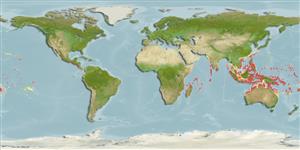Classification / Names
Common names from other countries
Main reference
Size / Weight / Age
Max length : 15.0 cm SL male/unsexed; (Ref. 48637)
Environment
Marine; reef-associated; depth range 1 - 30 m (Ref. 90102)
Climate / Range
Tropical, preferred ?; 30°N - 30°S
Distribution
Short description
Dorsal
spines
(total): 7;
Dorsal
soft rays
(total): 10-12;
Anal
spines: 1;
Anal
soft rays: 9 - 10;
Vertebrae: 26. Dorsal half of body brown, ventral half yellow, with 7-8 dark brown bars. Small silvery white spots on cheeks and opercula. Predorsal scales 8 or 9. Usually, spines on 1st dorsal fin elongated into filaments with the 3rd and 4th typically longest; spine of 2nd dorsal fin with red and white alternating bands, spots on rays and membrane. Cycloid scales only on nape and isthmus. Cheeks and opercula fully scaled. Teeth small and tightly packed in jaws. Depth of body about 3.6-3.9 in SL (Ref. 90102).
IUCN Red List Status (Ref. 115185)
Threat to humans
Harmless
Human uses
Aquarium: commercial
More information
Common namesSynonymsMetabolismPredatorsEcotoxicologyReproductionMaturitySpawningFecundityEggsEgg development
ReferencesAquacultureAquaculture profileStrainsGeneticsAllele frequenciesHeritabilityDiseasesProcessingMass conversion
Tools
Special reports
Download XML
Internet sources
Estimates of some properties based on models
Phylogenetic diversity index
PD50 = 0.5312 many relatives (e.g. carps) 0.5 - 2.0 few relatives (e.g. lungfishes)
Trophic Level
2.8 ±0.30 se; Based on food items.
Resilience
Medium, minimum population doubling time 1.4 - 4.4 years (Preliminary K or Fecundity.)
Vulnerability
Low to moderate vulnerability (33 of 100)
Price category
